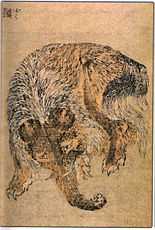Baku (spirit)

Baku (獏 or 貘) are Japanese supernatural beings that devour dreams and nightmares. They have a long history in Japanese folklore and art, and more recently have appeared in Japanese anime and manga (see examples cited below).
The Japanese term baku has two current meanings, referring to both the traditional dream-devouring creature and to the zoological tapir (e.g., the Malayan Tapir).[1] In recent years, there have been changes in how the baku is depicted.
History and description
The traditional Japanese nightmare-devouring baku originates in Chinese folklore and was familiar in Japan as early as the Muromachi period (14th-15th century).[2] Hori Tadao has described the dream-eating abilities attributed to the traditional baku and relates them to other preventatives against nightmare such as amulets. Kaii-Yōkai Denshō Database, citing a 1957 paper, and Mizuki also describe the dream-devouring capacities of the traditional baku.[3]
An early 17th-century Japanese manuscript, the Sankai Ibutsu (山海異物), describes the baku as a shy, Chinese mythical chimera with an elephant’s trunk, rhinoceros eyes, an ox tail, and tiger paws, which protected against pestilence and evil, although eating nightmares was not included among its abilities.[1] However, in a 1791 Japanese wood-block illustration, a specifically dream-destroying baku is depicted with an elephant’s head, tusks, and trunk, with horns and tiger’s claws.[4] The elephant’s head, trunk, and tusks are characteristic of baku portrayed in classical era (pre-Meiji) Japanese wood-block prints (see illustration) and in shrine, temple, and netsuke carvings.[5][6][7][8] Writing in the Meiji era, Lafcadio Hearn (1902) described a baku with very similar attributes that was also able to devour nightmares.[9]
Modern representations
Since the 1980s, the baku appears not as a chimera of an elephant and tiger but as a zoologically recognizable tapir. Examples include:
- Oshii Mamoru’s 1984 animated film Beautiful Dreamer,[10][11] which is based on an episode of Rumiko Takahashi's manga Urusei Yatsura (1978–1987) that depicts the baku as a tapir.[12]
- They also appear in Haruhiko Mikimoto's manga Marionette Generation (2001, original 1990).[15]
Dream-eating, tapir-shaped baku have also entered non-Japanese popular culture:
- The picture book "The Dream Eater" by Christian Garrison tells the story of a young boy, Yukio, who meets a baku and brings it to his village.[16]
Gallery
-

Baku and Lion at the Konnoh Hachimangu Shrine, Shibuya, Tokyo, Japan
See also
- Dreamcatcher
Notes
References
- ↑ 1.0 1.1 Nakagawa Masako 1999 "Sankai ibutsu: An early seventeenth-century Japanese illustrated manuscript". Sino-Japanese Studies, 11:24-38. Pages 33–34.
- ↑ Hori Tadao 2005 "Cultural note on dreaming and dream study in the future: Release from nightmare and development of dream control technique," Sleep and Biological Rhythms 3 (2), 49–55.
- ↑ Mizuki, Shigeru 2004 Mujara 5: Tōhoku, Kyūshū-hen (in Japanese). Japan: Soft Garage. page 137. ISBN 4-86133-027-0.
- ↑ Kern, Adam L. 2007 Manga from the Floating World: Comicbook culture and the kibyoshi of Edo Japan. Cambridge: Harvard University Asian Center. Page 236, figure 4.26.
- ↑ 夢貘まくら. (Accessed September 5, 2007.)
- ↑ Richard Smart, "Delivering men from evil", Japan Times, February 16, 2007. (Accessed September 8, 2007.)
- ↑ http://www.onmarkproductions.com/html/shrine-guide-2.shtml. (Accessed September 8, 2007.)
- ↑ http://collectionsonline.lacma.org/mwebcgi/mweb.exe?request=image;hex=M91_250_104.jpg (Accessed October 12, 2010.)
- ↑ Hearn, Lafcadio 1902 Kottō: Being Japanese Curios, with Sundry Cobwebs. Macmillan. Pages 245-248. ISBN 4-86133-027-0.
- ↑ Oshii Mamoru 1984 Beautiful Dreamer. New York: US Manga Corp. ASIN: B0001Y4MRW.
- ↑ Ruh, Brian 2004 Stray Dog of Anime: The Films of Mamoru Oshii. New York: Palgrave Macmillan.
- ↑ Takahashi Rumiko 1995 Waking to a nightmare. In: The Return of Lum: Urusei Yatsura. San Francisco: Viz. Pp. 141–156.
- ↑ http://www.pokemon.com/us/pokedex/#96
- ↑ Digimon Dictionary: Bakumon
- ↑ Mikimoto Haruhiko 2001 (original 1990). A Profile of the Heart. In: Marionette Generation, Volume 1, San Francisco: Viz Communications. Pages 159-178.
- ↑ Garrison, Christian (1978). The Dream Eater. Scarsdale, NY: Bradbury Press. ISBN 0-87888-134-4.
- Kaii-Yōkai Denshō Database. International Research Center for Japanese Studies. Retrieved on 2007-05-12. (Summary of excerpt from Warui Yume o Mita Toki (悪い夢をみたとき, When You've Had a Bad Dream?) by Keidō Matsushita, published in volume 5 of the journal Shōnai Minzoku (庄内民俗, Shōnai Folk Customs) on June 15, 1957).
External links
- Baku – The Dream Eater at hyakumonogatari.com (English).
- Netsuke: masterpieces from the Metropolitan Museum of Art, an exhibition catalog from The Metropolitan Museum of Art (fully available online as PDF), which contains many representations of Baku
